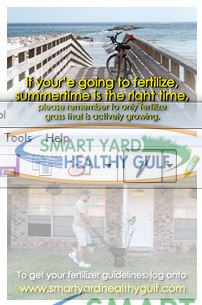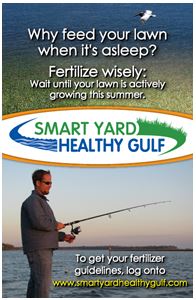 |
June 2013
|
June 2013 // Volume 51 // Number 3 // Ideas at Work // v51-3iw7
Smart Yard, Healthy Gulf: Using Community-Based Social Marketing to Educate Gulf of Mexico Residents on Proper Lawn Care Practices
Abstract
Smart Yard, Healthy Gulf is an environmental stewardship campaign that uses community-based social marketing to educate homeowners on lawn care practices and residential nutrient runoff. The goal is to change homeowners' behavior regarding lawn care practices using simple, easily remembered messages that guide them on timing of fertilizer applications. Most Smart Yard, Healthy Gulf participants are middle class homeowners living in the Gulf of Mexico region who maintain their own lawns. The campaign is a collaborative effort with the Mississippi-Alabama Sea Grant Consortium, the Gulf of Mexico Alliance, and the Cooperative Extension Services in the five Gulf of Mexico States.
Introduction
Concern over the contribution of residential fertilizers to nutrient loading in waterways has spurred a recent focus on the impact that homeowners' lawn care practices have on water resources (Hefner, Robertson, Coulter, & Stevens, 2009; Sewell, McCallister, Gaussoin, & Mortmann, 2010), particularly in the Gulf of Mexico (Alabama A & M and Auburn Universities, 2010). Fertilizers applied at the wrong time may result in nutrient runoff to water bodies, contributing to the formation of hypoxic zones (University of South Florida, 2009). Hypoxic zones negatively impact the ecological and economic wellbeing of the Gulf of Mexico (NOAA, 2008).
Community-based social marketing seeks to influence social behavior to benefit a target audience as well as society as a whole (Kotler, Roberto, & Lee, 2002; Skelly, 2005). Social marketing focuses on influencing attitudes and values of a target audience through education and experiential activities (Lefebvre, 2000; Snow & Benedict, 2003). A social marketing plan (SMP) conducted by the University of South Florida's (USF) Center for Social Marketing was developed for the Gulf of Mexico Alliance (GOMA), a state-led, non-profit organization in the Gulf of Mexico whose aim is to improve the ecological and economic health of the region. The SMP outlined the steps GOMA would need to take in developing a successful nutrient-reduction campaign aimed at changing the way Gulf of Mexico homeowners fertilized their lawns. The USF SMP identified the USDA Cooperative Extension System as a trusted source for educating the public on lawn care and landscape practices and recommended establishing a strong partnership with Extension's Master Gardener Programs in all five U.S. Gulf States. The USF SMP identified this as an integral step in developing a nutrient-reduction campaign for the Gulf of Mexico region.
Brand and Message Development
The USF plan also recommended developing a brand that the target audience, Gulf of Mexico homeowners who maintain their own lawns would recognize and understand. Through a series of workshops and focus groups, a short list of 20 brands and 35 messages was generated. Eventually, the list of brands was narrowed down to two that emphasized fertilizing "smart" and keeping the Gulf of Mexico "healthy." The two brands that were tested at all four focus groups were: 1) Healthy Lawn, Healthy Gulf and 2) Gulf Smart Yard. During one focus group, a participant recommended combining the two aforementioned brands to form a more cohesive brand, Smart Yard, Healthy Gulf. This brand was subsequently tested at two more focus groups. It tested the highest among all focus group participants and therefore became the brand for the GOMA nutrient-reduction campaign.
Two initial logos were created to illustrate the Smart Yard, Healthy Gulf brand. The words "Smart Yard" and "Healthy Gulf" were linked by two individual swooshes in the colors green and blue, to signify grass and the ocean.
Both logos were tested among focus group participants and program sponsors, including Extension agents and Master Gardener volunteers. Participants were asked to pick their favorite logo color and font, and comment on their likes and dislikes about each logo. Most comments were received via email and were simple to tally. The logos were modified based on feedback received from these groups. The majority of the project participants preferred the upper case lettering. Several participants suggested adding waves to the blue swoosh and grass to the green swoosh to simulate waves found in the Gulf of Mexico and grass on home lawns. These comments were incorporated into the final logo (Figure 1).
Figure 1.
Final Version of the Smart Yard, Healthy Gulf Logo

In addition to brand testing, the focus groups were successful in determining which messages best resonated with the target audience. Social marketing attempts to use messages that are both appealing and memorable. The messages for the Smart Yard, Healthy Gulf campaign focus on the issue of proper timing of fertilizer applications for the Gulf of Mexico coastal region, where the appropriate season to fertilize home lawns is in the summer. The series of workshops and focus groups led to the development of the following two messages.
- "If you're going to fertilize, summertime is the right time."
- "Why feed your lawn when it's asleep?"
The first message, "If you're going to fertilize, summertime is the right time," is used during the spring and summer seasons, while the second message, "Why feed your lawn when it's sleep?" is used during the fall and winter seasons. Each message was paired with a photograph that depicts the goal of the message. The message "If you're going to fertilize, summertime is the right time" illustrates a male homeowner fertilizing his yard using an appropriate method, a drop spreader, and links an image of the Gulf of Mexico to the fertilization activity (Figure 2).
Figure 2.
Message Number One Demonstrating the Proper Time and Method of Lawn Fertilization for the Gulf of Mexico Region

The second message, "Why feed your lawn when it's asleep?" is paired with a picture of a male participating in an activity other than fertilizing, fishing from a dock. This message and image seek to influence the homeowner to refrain from fertilizing during the fall and winter seasons by promoting a recreational activity, fishing, instead of fertilizing (Figure 3).
Figure 3.
Message Number Two Demonstrating the Time of Year to Participate in Activities Other Than Lawn Fertilization

Outcomes
Using the Smart Yard, Healthy Gulf brand and message(s), unique educational materials specific to lawn care/maintenance were created, including rain gauges, seed tins, tote bags, yard signs, refrigerator magnets, posters, a brochure, a website (www.smartyardhealthygulf.com), and a lawn prescription tool.
The Smart Yard, Healthy Gulf campaign was successfully launched March 2011 in three coastal counties in Mississippi and Alabama. Master Gardeners and Master Naturalists have promoted the Smart Yard, Healthy Gulf campaign through hundreds of volunteer hours spent handing out materials at local farmers markets, plant sales, garden clubs, and one-on-one interactions with homeowners.
Similar programs in other regions of the country could be established by developing comparable partnerships with local Master Gardener and Master Naturalist Programs. Challenges exist for Extension educators even when their audience consists of homeowners who possess environmentally conscious knowledge and attitudes because even environmentally minded homeowners may need further motivation to translate their beliefs into actions (Mangiafico, Obropta, & Rossi-Griffin, 2012). Extension educators may need to incorporate creative measures into future programs to ensure that homeowners adopt the appropriate lawn-care actions.
References
Alabama A & M and Auburn Universities. (2010). Alabama Smart Yards: Introducing environmental consciousness and practical management options to our yards and neighborhoods. ANR-1359. Retrieved from: http://www.aces.edu/pubs/docs/A/ANR-1359/ANR-1359.pdf
Hefner, S. G., Robertson, C., Coulter, A., & Stevens, G. (2009). Engaging citizens to urban nutrient planning of lawns within a nutrient sensitive watershed. Journal of Extension [On-line], 47(4) Article 4IAW5. Available at: http://www.joe.org/joe/2009august/iw5.php
Kotler, P. Roberto, W., & Lee, N. (2002) Social marketing: Improving the quality of life (2nd Edition). Sage Publications.
Lefebvre, R. C. (2000). In P. N. Bloom & G. T. Gundlach (Eds.), Handbook of marketing and society. Newbury Park, CA: Sage Publications.
Mangiafico, S., Obropta, C., & Rossi-Griffin, E. (2012). Demographic factors influence environmental values: A lawn-care survey of homeowners in New Jersey. Journal of Extension [On-line], 50(1) Article 1RIB6. Available at: http://www.joe.org/joe/2012february/rb6.php
National Ocean Service, NOAA. (2008). Gulf of Mexico at a glance. Washington, D.C.: U.S. Department of Commerce, National Oceanic and Atmospheric Administration. Retrieved from: http://gulfofmexicoalliance.org/pdfs/gulf_glance_1008.pdf
Sewell, S., McCallister, D., Gaussoin, R., & Mortmann, C. (2010). Lawn management practices and perceptions of residents in 14 sandpit lakes of Nebraska. Journal of Extension [On-line], 48(2) Article 2RIB4. Available at: http://www.joe.org/joe/2010april/rb4.php
Snow, G., & Benedict, J. (2003). Using social marketing to plan a nutrition education program targeting teens. Journal of Extension [On-line], 41(6) Article 6FEA4. Available at: http://www.joe.org/joe/2003december/a4.php
Skelly, J. (2005). Social marketing: Meeting the outreach challenges of today. Journal of Extension [On-line], 43(1) Article 1IAW1. Available at: http://www.joe.org/joe/2005february/iw1.php
The University of South Florida. (2009). Gulf of Mexico Alliance environmental awareness campaign social marketing plan. Retrieved from: http://www.gulfallianceeducation.org/PDF%20public%20awareness/
GOMA%20Marketing%20Plan.pdf




